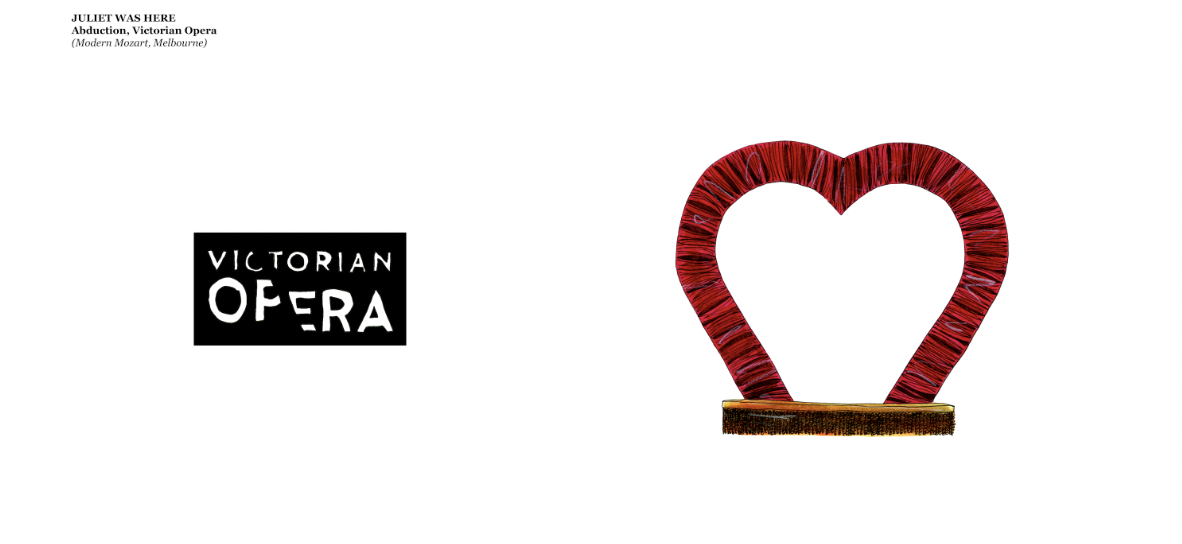JULIET WAS HERE | Abduction, Victorian Opera
ABDUCTION AT THE PALAIS
(Modern Mozart, Melbourne)
A few weeks ago, I bumped into my friend Scott at the theatre. The next day he messaged: You have to come to the opera. Scott works for Victorian Opera. I told him I had never been before. He promised the one he had in mind would be “the perfect first one to see.”
A moment later my phone buzzed with a photo, a model of the set design. “Imagine The Great Gatsby, Rocky Horror, and Moulin Rouge combined.”
Say less, Scott.
Two tickets for Abduction landed in my inbox just like that and Sam and I were going to our first opera.
The foyer of the Palais Theatre was buzzing when we arrived. Scott was there to greet us, sleek and beaming, looking as if he had stepped straight out of Gatsby’s party. Everyone knew him. “So lovely that you could make it,” he said, before melting back into the crowd.
We each ordered a double prosecco and a KitKat, then wandered to peek at the stage. A red heart in the centre, red velvet curtains behind it, suggestive without revealing much. Upstairs, we found ourselves on a leather couch, joined by an older couple. When the man went to get a program, Sam offered him one of ours, and just like that we were in conversation.
They told us about the time in the 1970s when, due to political wrangling, Victoria lost its opera company and Sydney claimed the mantle as The Australian Opera. They spoke of singers they knew in the program, voices they admired, choirs they still sang in. The man had even relearned how to sing after getting hearing aids.
In the crowd around us there was a man in a flamboyant three-piece suit, a woman in long black opera gloves pointing to the program with cinematic precision. Sam and I whispered to each other, Who goes to the opera? Not as in why, but literally, who are they? The answer, it seemed, was people who love it enough to support it, remember its history, and keep singing themselves.
The lights dimmed and we were pulled into another world. This Abduction was a modernised take on one of Mozart’s most famous works, bits cut, shuffled, remixed, just as he might have done if he were alive today. Written almost 250 years ago yet full of references to Aldi ladders, Officeworks flyers and contemporary Australian slang woven seamlessly into the arias.
By intermission, Sam and I were plotting to dress and behave like the characters in the Pasha’s palace, free, playful, a little bit decadent. I wanted the heart-shaped mirrors for home. I wanted the bellboys dressed like something out of a sexy Wes Anderson film to hand me a champagne.
While Sam queued for the bathroom, I met Hilary with one L. She had been coming to the opera since she was nine, now brought her grandchildren. “I am so glad you are not an opera virgin anymore,” she told me, leaning in conspiratorially.
We took the tram home together. Another glamorous passenger overheard us and joined in. As she stepped off, she called back, “It was excellent. Everyone should go to the opera, run there.”
Sam said the whole scene on the tram reminded him of Nana, the Émile Zola novel we are reading about a dazzling stage performer whose life blurs the line between spectacle and reality, and the audience who orbit her. This night felt like that, a performance inside a performance, and a whole cast of characters offstage.
This one will stay with us for a while and it will definitely not be our last. Do yourself a favour, go to the opera, run there.

